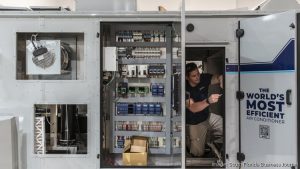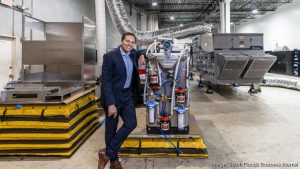South Florida simply wouldn’t exist in its modern form without air conditioning. Just ask anyone who’s ever endured one of its brutally hot, humid summers.

Once a steamy and largely uninhabitable frontier, the Miami region experienced explosive growth after air conditioning became widely available in the 1950s. AC transformed it from a seasonal destination into a year-round metropolis and economic powerhouse. But there’s a catch: While air conditioning cools our homes and offices, it also heats the planet. And as global temperatures climb, demand for AC is rising—setting off a vicious cycle.
Cooling also comes with a hefty price tag. It’s one of the biggest expenses for residential, commercial, and industrial buildings. That’s why real estate companies are actively hunting for energy-efficient solutions to cut cooling costs.
Given its history, it’s no surprise South Florida is at the forefront of the solution. Companies like Boca Raton-based Blue Frontier are pioneering new technologies that aim to use less energy, emit fewer pollutants, and perform better during extreme heat.
“Air conditioning is the fastest-growing appliance market for buildings and the fastest-growing use of electricity worldwide,” said Blue Frontier CEO Daniel Betts. “We have technology that can completely transform this space.”
Reinventing How We Stay Cool
There’s huge potential for innovation in the cooling industry. According to the International Energy Agency, air conditioning makes up about 10% of global energy use and 3% of greenhouse gas emissions. Traditional HVAC systems rely heavily on fossil fuel-powered electricity, which worsens climate change.
Legacy players like Carrier Global Corp., based in Palm Beach Gardens, are improving traditional systems with innovations like smart thermostats that adjust indoor temperatures during peak hours to lower electricity use and bills.
“Carrier has pledged $2 billion to develop smarter HVAC solutions that aim to cut heating and cooling emissions dramatically by 2030,” said Brooke Greenwood, the company’s director of product management.

But Blue Frontier is taking a different approach—redesigning the system altogether. Founded in 2017, Blue Frontier replaces traditional refrigerants with a liquid salt solution that cools and dehumidifies air more efficiently and without pollution. Its systems also store electricity, which allows them to operate during peak demand without stressing the grid.
The results? Up to 50% to 90% less energy use and potential savings of $10,000 a year for commercial customers. Fewer compressor and fan cycles also mean less wear and tear, reducing maintenance costs and extending equipment life. Plus, the non-toxic cooling liquid in Blue Frontier’s system recirculates throughout its 15- to 20-year lifespan—no need for constant refills. And thanks to Inflation Reduction Act tax rebates, upfront costs are competitive, with payback periods ranging from three to five years.
“We’re starting with commercial buildings—the ‘gas guzzlers’ of real estate,” said Betts. “But we plan to expand into residential, too.”
Big Players Are Paying Attention
Blue Frontier’s innovation is turning heads. Backed by Bill Gates’ Breakthrough Energy Ventures, the company is already working with major institutions. The U.S. Department of Defense, Waffle House, and Barry University are piloting the technology. And in July, Blue Frontier signed a deal with CM Fabrication to manufacture its systems in Sycamore, Illinois. Even real estate giant CBRE is testing a unit at one of its Delaware properties.
“Sustainability and tech are becoming major value drivers for real estate,” said Jeff Dunbar, CBRE’s senior sustainability director.
More Than Just Green — It’s Smart Business
You don’t have to be an environmentalist to care about efficient air conditioning. Lower utility bills are a compelling incentive, especially for businesses in large office or industrial spaces. HVAC systems make up about 40% of total energy use in U.S. commercial buildings. In 2018, commercial buildings spent an estimated $141 billion on energy—with cooling responsible for a big slice.
Companies like JLL are exploring how to make HVAC systems more sustainable for tenants, said Christian Whitaker, global head of technical services and sustainability. But it’s not always simple.
“The cost to overhaul a 100-year-old building is very different from updating a modern high-rise,” Whitaker said.
Still, in hot regions like Florida and Texas, the return on investment is clearer.
“Owners in these areas already spend more on cooling,” he said. “So the long-term savings make better systems a smarter bet.”
And as Betts points out, saving money resonates with everyone:
“Air conditioning isn’t political—it’s something we all rely on. You don’t need to care about sustainability to appreciate lower energy bills.”
Why the Timing Is Right
There’s never been a better moment to innovate in cooling. Global demand for air conditioning is expected to triple by 2050, driven by rising temperatures, urban growth, and more construction—especially of energy-hungry data centers.
Carrier is already seeing soaring demand in the Sun Belt, where population growth, older infrastructure, and constant heat create ideal conditions for year-round cooling.
In 1970, Miami-Dade saw 84 days over 90°F. In recent years, that number has jumped to 133 days. And 2023 set a record at 139 days. Meanwhile, the number of days with a heat index over 105°F hit 48—dangerously high and increasingly common. Northern states are also feeling the heat, sometimes experiencing blackouts due to AC-driven electricity demand.
Investors are taking notice. Firms like Goldman Sachs Alternatives have been busy acquiring HVAC companies. Between 2020 and 2024, private equity firms closed 185 deals in the HVAC space, according to PitchBook.
“I have the simplest job in the world—I’m selling air conditioning,” Betts said. “When it’s 100 degrees outside, staying cool isn’t a luxury—it’s a necessity.”
Source: SFBJ

